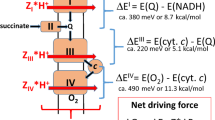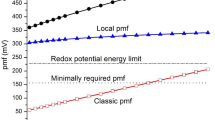Abstract
IN previous communications1,2 it was shown that several antihistamine drugs in concentrations which do not affect respiration or phosphorylation reduce the rate of swelling of isolated mitochondria and also diminish the rate of extrusion of water by these particles. It was found that the drugs greatly reduce the rate of turnover of phosphoprotein phosphorus in such systems. This work has now been extended, and it has been found that a variety of agents which affect mitochondrial swelling and ‘contraction’ also affect the phosphorylation of proteins. A similar relation appears in liver slices taking up and extruding water under appropriate conditions. Amytal and azide inhibit mitochondrial ‘contraction’3, whereas 2,4-dinitrophenol does not. Phosphoprotein–phosphorus falls to low levels during swelling, and compounds which prevent this change preserve the phosphoproteins; this, however, might be a secondary phenomenon. During ‘contraction’ there is phosphorylation of protein; this is shown in Table 1, which also shows the effects of amytal, azide, 2,4-dinitrophenol and ‘Phenergan’, a phenothiazine antihistamine drug. It will be seen that there is a correlation between the increase in optical density of the mitochondrial suspension and the phosphorylation of protein. If the time-course of ‘contraction’ is followed, there is a close correlation between these two processes. Furthermore, if the mitochondria are allowed to re-swell, this event is preceded by a fall in phosphoprotein-level, even in the presence of excess adenosine triphosphate.
This is a preview of subscription content, access via your institution
Access options
Subscribe to this journal
Receive 51 print issues and online access
$199.00 per year
only $3.90 per issue
Buy this article
- Purchase on Springer Link
- Instant access to full article PDF
Prices may be subject to local taxes which are calculated during checkout
Similar content being viewed by others
References
Judah, J. D., Nature, 185, 390 (1960).
Judah, J. D., Exp. Cell Res., 19, 404 (1960).
Lehninger, A. L., J. Biol. Chem., 234, 2465 (1959).
McLean, A. E. M., Nature, 185, 191 (1960).
Gallagher, C. H., Gupta, D. N., Judah, J. D., and Rees, K. R., J. Path. Bact., 72, 193 (1956).
McLean, A. E. M., Nature, 185, 936 (1960).
Judah, J. D., Bjotvedt, G., and Vainio, T., Nature (in the press).
Author information
Authors and Affiliations
Rights and permissions
About this article
Cite this article
JUDAH, J. Phosphoproteins and Mitochondrial and Cell Water. Nature 187, 506–507 (1960). https://doi.org/10.1038/187506a0
Issue Date:
DOI: https://doi.org/10.1038/187506a0
This article is cited by
-
Properties and Stabilization of the Lysosomal Membrane
Nature (1966)
-
Phosphoprotein Metabolism and Ion Transport in Nervous Tissue : A Suggested Connexion
Nature (1962)
-
Sodium Transport and Phosphoproteins
Nature (1962)
Comments
By submitting a comment you agree to abide by our Terms and Community Guidelines. If you find something abusive or that does not comply with our terms or guidelines please flag it as inappropriate.



